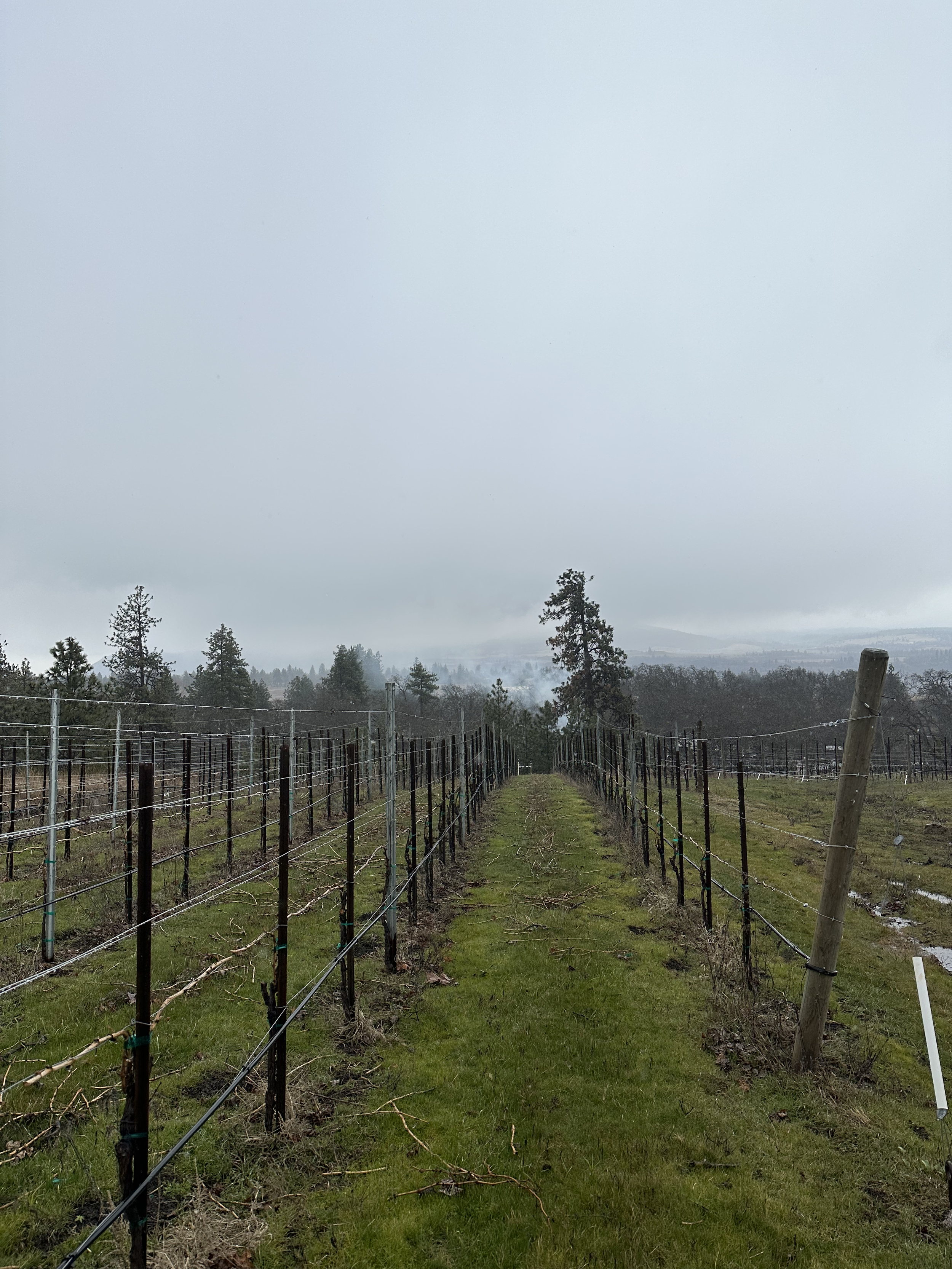Columbia Gorge, Washington
I’m stood in a vineyard, my shoes wet in the green, muddy grass, the rain drizzling down in the cold, lightly snow-capped mountains hazy in the distance, my notebook hidden under my coat, waiting for the winemaker to take us away from the vineyard and back into the cellar, thinking, “Am I in the north of England right now?”, reminding myself I’m (just about) in Washington State.
Back in the cellar, now that pen and paper are dry, I hurriedly write some notes on what James Mantone of Syncline Winery has said while we were shivering in the vineyard. The vines right next to us were Furmint, planted three years ago and which has been a struggle to work with. There are a couple of dozen wildflowers, growing as natural cover crop. Farming is biodynamic but not certified: they have the paperwork, but it’s never been completed (a combination of laziness and bureaucracy). The Columbia River we could just about see: in the winter it used to flow fast and hard and flood the land. It was dammed in 1956, controlling the flow but decreasing the organic matter in the soils now planted to vines. The aim at Syncline is to naturally encourage fungal growth in the soils for a regenerative, healthy growing environment: having just started watching “The Last of Us” I am nervous.
furmint vines in columbia gorge
We are in Columbia Gorge, a small AVA that straddles the Columbia River between the states of Washington and Oregon. Columbia Gorge is beautiful, mountains lining either side of the river, just over an hour’s drive inland from Portland. Like many wine regions in the two states, plantings are relatively new. This means experimentation with grape varieties, figuring out how to work with the growing conditions, and dealing with both federal and state government regulations which have little to do with wine.
Washington and Oregon are remote states, despite the big cities of Seattle and Portland. James tells us of traceable wagon tracks above their property when there were no roads, and when it took two days to go from one farm to another. We had driven from Bend, a skiing and beercentric town three hours south in Oregon, through the pass beneath Mt. Hood. We were lucky, as the road was lightly snow-covered; two days later, it was blocked from heavy snowfall. From the vineyard, we could just about see Mt. Hood on the other side of the river.
Columbia River is large, direct, and impressive, dividing Washington from Oregon. There are toll bridges connecting the two states, but the main highway is just east of Portland and is the easiest way to get from one state to the other. The river provides irrigation, which is highly regulated with limited water access for the wineries in Columbia Gorge and other Washington wine regions. The land within 3km of the river falls within federal jurisdiction, which further limits water usage: even wells on wineries’ properties fall under federal supervision, as well as any new buildings.
It’s hard to imagine when visiting in wet, almost snowy, early March, but it gets hot in Columbia Gorge in the summer months. The rain that falls over the winter is used up by the time of véraison and some irrigation is needed to keep the vines productive towards harvest. At Syncline, they’re introducing an irrigation system for newly-planted vines called “Direct Source”: the irrigation is buried beneath the surface for direct access to the roots. This limits irrigation while helping the vines build a deeper root system and addressing issues of water shortage.
They’re not afraid to experiment at Syncline, and all the better for it. Grenache has been planted seemingly on a whim as there’s little expectation that it will ripen: but who knows? That experimentation has mostly taken them in the right direction so far (even if the Furmint continues to frustrate). There’s Gamay planted with head-trained vines, just like Beaujolais. There are two pickings of the fruit: the first begins fermentation with carbonic maceration and then the second lot is placed on top. The carbonic maceration results in bright fruit and a savoury character with a firm, tannic structure from the second picking. The result: just about as good a Gamay as you’re going to find outside Beaujolais.
Syncline also make deep-coloured, tannic Mondeuse, skin-contact Grüner Veltliner, and a Blanc de Noirs aged for eight years, giving some sense of what this small, beautiful area is capable of. And this is just the beginning: on the other side of the river, winemaker Nate Ready of Hiyu Wine Farm has planted over 140 varieties on his site. He has taken experimentation to an extreme level. Having bought cuttings of all those varieties, he put them into a bin, mixed them all up, left them for a while so he’d had no idea which was which, and planted them randomly. All because he didn’t want to be influenced by any perceptions he held about each variety. (James of Syncline complains, “How are we supposed to learn which varieties work in Columbia Gorge, if even Nate doesn’t know what he’s planted?”)
There’s definitely a Portlandia vibe to Columbia Gorge—Hiyu’s description of the area on their website begins:
Upon this valley, the omnipotent mountain routinely asserts her mercurial hand. Frigid gusts challenge temperate drafts and clouds compete with sunbeams. Storms swirl, rainbows propagate, and the volcanic soil eternally churns. Reading between these celestial and terrestrial signs, humans gently steer the land — co-creators of a startling alchemy.
The language continues at some length, but I’m with that description. After all, it’s not often I stand in a vineyard and start thinking of the Brontës and their dark, melodramatic, intense evocations of the Yorkshire Moors. Reader, drink Columbia Gorge.
producers to try: Syncline, Hiyu, Savage Grace, Analemma: all with a holistic approach to grape growing and winemaking





